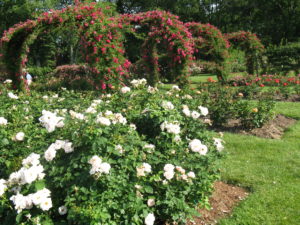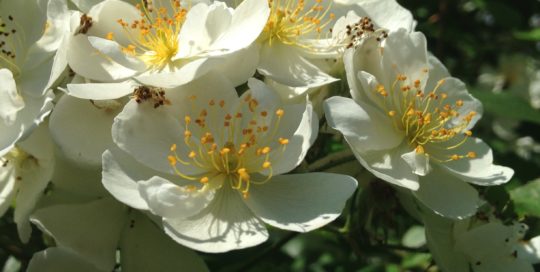July Pruning and Rosy-Related Ramblings 1
Views: 1539

Today’s blog is part one of two on pruning roses (and other rosy-related ramblings). It will concentrate on once blooming (or non-remontant) roses. My next blog will discuss pruning repeat blooming (or remontant) roses (and other rosy-related ramblings).
July is often an interesting and sometimes tenuous month in my garden. Yes, the roses continue to bloom throughout the month. And, yes, more often than not, they can be quite beautiful. But, it is a month where most of my roses are rejuvenating themselves for a fall flush. Blackspot also starts to set in if the roses aren’t sprayed regularly, and it’s time to do the summer pruning. I also need to make decisions on whether or not to let the hips form on the roses. Either I can get new rose babies, or prune the spent blooms and not worry about it.
The first thing that I recommend when it comes to pruning time is knowing your roses and how you want to use them. As an amateur hybridizer, I want to know the value of every rose in my garden (especially its value as a seed parent). If you are not interested in discovering how your roses act in regards to seed germination, please ignore this next section.
Hold the pruners – I want to create new roses
Hybridizing and creating new roses is the part of the rose-growing hobby that piques my interest the most. When I get roses that are new to my garden, one of the things that I like to do is to not prune the spent blooms, and let the roses form hips. I later try to germinate any seeds created within and see what develops. One can tell a lot on how good (or how bad) a rose’s value as a seed parent can be by doing this. I have made some amazing discoveries this way. Some of the roses I have introduced have started out life as simple germinating experiments.
To do this, one only has to only go against conventional wisdom set forth by most rosarians and not prune your roses. If you are interested in pursuing this, now is the time to not prune. I also highly recommend letting anyone else who works in the garden know that you are saving the hips to germinate any seeds that develop, and to not deadhead. Yes, you will have fewer blooms through the rest of the season if you let hips develop. And, yes, you will have shorter plants than if you prune the developing hip(s) and allow your roses to re-bloom. A future blog will address methods for getting the seeds planted and creating your own baby roses. More information on creating your own rose babies can also be found through the Rose Hybridizers Association – www.rosebreeders.org.
Remontant vs. non-remontant roses
Roses are either remontant (repeat blooming) or non-remontant (once blooming). Many non-rose shrubs and plants are once blooming, and most gardeners accept this, and embrace this without question. Plants such as hydrangeas, peonys, rhododendrons, forsythias, lilacs, etc. are all once blooming. The rose-growing world does not always accept once blooming roses as being good roses worthy of a place in their gardens.
I feel as though this can be a mistake in judgment as many once blooming roses have extended blooming periods with larger quantities of blooms than what many modern repeat-blooming roses offer. One only has to visit Elizabeth Park in West Hartford, Connecticut when the archways are in bloom, to see how visually stimulating and valuable once-blooming roses can be. I have about 30-40 plants of various once blooming roses, and I can attest that they do often pack quite a lot of flower power when they bloom. Many of these same roses are highly fragrant and will blow you away with their intoxicating scents.
I have many once blooming roses that are old garden roses as well as some that are Hybrid Wichuranas (ramblers). I would also like to point out that while most old garden roses are once blooming, not all are. Do not assume that all old garden roses are non-remontant. While most Teas, Chinas, Portlands, Rugosas, and Hybrid Perpetuals are remontant, but so are many Mosses, Bourbons, Hybrid Multifloras, and Damasks. Pruning once blooming roses is different than pruning remontant roses, and you need to know if your roses are once blooming or remontant before you start pruning.
Pruning non-remontant (once blooming) roses
I recommend pruning once the roses finish blooming soon after they bloom in the spring or summer. It is important to remember that anything that is pruned off the rose now, will result in fewer blooms next season. Dead and diseased canes should be taken out. These canes should be taken out any time, not just in the summer. Once the dead and damaged canes are removed, this year’s flowering canes are cut back by about one third. Be on the lookout for canes that have bloomed for a couple of years, and are not very productive. These non-productive canes should be removed as well (as long as they don’t have any new growth coming from them). After these canes are removed, the plant is shaped as desired, but be mindful that every part of the plant that is removed now, will result in fewer blooms next year.
New canes – next year’s blooms
I am always on the lookout for new canes. These new canes can arise from the base of the rose or anywhere else in the plant and through runners that arise next to the original plant. These new canes are next year’s blooms. I take special care not to damage them. Also, I try to train them where I want them to bloom next year. I walk by my once blooming rambling and upright-growing once blooming roses at least once a week during the growing season.
As I find these new canes, I decide where I want next year’s blooms to be, and help guide these new canes this way. Usually, these new canes are flexible enough to allow me to do this. I sometimes tie these canes down with string or green ties, but many times I just let the cane and its prickles grab on to arbors as I thread them through. I will warn you that these new canes are sometimes quite soft and will break if not handled with the utmost care. Also, I usually let the canes get to be a few feet long before starting to attach them through the arbors. This also allows the canes to harden off somewhat, but still be flexible enough to train.
Once blooming “running” roses
Many once blooming old garden roses are lower-growing. They multiply by sending runners through the ground next from the mother plant as they grow. Such roses as Gallicas, Species, Centifolias, Rugosas (Rugosas are usually remontant), etc. grow this way. Pruning these once blooming varieties is basically the same as their larger bushy and climbing counterparts. However, when you want to the spread of these roses, I recommend digging up the runners when they appear, severing them from the mother plant, and discarding them (or sharing them with other rosarians). I attained almost all of my roses that spread through runners this way. I have even found some happily growing in old homesteads untended for decades, dug them up, and taken them home.
Well we have come to the end of today’s blog. Some future blogs will discuss different types of old garden roses, their beauty, charm, and uses.
Epilogue & correction
I originally wrote this blog with my trustee black Osmiroid pen with the Esterbrook tip that I used a couple of times in the past. I use this pen daily and when the inspiration to write arises. Usually, I am assured that it is full of ink and ready to go. It is my go-to pen and one of my favorites.
Correction from the last blog – a reader brought to my attention that I incorrectly identified the class of Bright and Shiny in my last blog. Bright & Shiny is a floribunda, not a climbing rose. I’m not sure where I got the idea it was a climbing rose? I probably crossed two different roses when I initially researched Bright and Shiny. I looked on Helpmefind when I was working on my last blog, and the website had the class listed as unknown, but this has been rectified. Please accept my humble apologies for misleading you.
Meet Andy Vanable
Andy's Recent Posts

The Rose-Growing World Loses an Icon – Bob Martin






